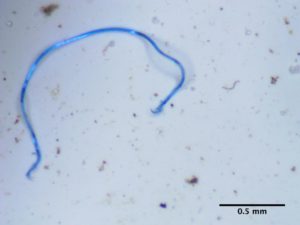 Tiny particles of plastic, called microplastics, have now been detected in human blood. Yikes! We all know that plastic pollution is a serious problem in the environment, but recent research has been finding it in our food, in the air, in water, in rain, our organs (including our lungs and brain), human placentas, and now in our blood.
Tiny particles of plastic, called microplastics, have now been detected in human blood. Yikes! We all know that plastic pollution is a serious problem in the environment, but recent research has been finding it in our food, in the air, in water, in rain, our organs (including our lungs and brain), human placentas, and now in our blood.
The most widely found microplastic particles in the blood were polyethylene terephthalate (PET) (commonly used in disposable water bottles), and polystyrene (PS), which is used for food packaging and polystyrene foam.
The big question is: What are microplastics doing to us, if anything?
The first studies are finding that microplastics are causing inflammation and damage to cells (not good), and are building up in us, but we don't really know much at all. Will it increase the risk of cancer? Scientists are also concerned over the chemicals in the microplastics. For example, if there are endocrine disrupting chemicals in the microplastics, then what effect (if any) are they having on us?
But... plastic production is increasing every year, so we can expect to be exposed to more plastic over time, which means more will get into us and the environment. And the particles will build up.
You may wonder why there are so many little plastic particles out there - it's because plastic breaks apart over time. Even when we do laundry - there are little plastic particles released into the drain water from synthetic fabrics. When we drink from plastic water bottles, little plastic particles released from the bottles are ingested by us. And yes, water bottles are a big source of microplastics ingested by us - up to an additional 90,000 microplastics per year!
Bottom line: try to cut back on your use of plastic, which means buying less of plastic goods - for example, in beverage containers (opt for glass bottles instead), in furniture and toys, in our homes (wood or tile instead of vinyl as much as possible). Avoid drinking from plastic water bottles.
From Smithsonian: Microplastics Detected in Human Blood in New Study
Microplastics, or tiny plastic particles, are ubiquitous pollutants found almost everywhere on earth. Scientists have detected microplastics near the peak of Mount Everest, in the Mariana Trench and even in baby poop. But researchers have now found a new vessel for microplastics: human blood.
In a paper published in Environment International, researchers found plastic in the blood of 17 of 22 of study participants, or about 77 percent.
“Our study is the first indication that we have polymer particles in our blood – it’s a breakthrough result,” says study author Dick Vethaak, an ecotoxicologist at Vrije Universiteit Amsterdam in the Netherlands, to the Guardian’s Damian Carrington. “But we have to extend the research and increase the sample sizes, the number of polymers assessed, etc.”
Researchers took blood samples from anonymous, healthy adults, and looked for plastics that were between 700 and 500,000 nanometers (nm). Seven hundred nm is around 140 times smaller than the width of a human hair, writes The Wire Science’s Aathira Perinchery.
Polyethylene terephthalate (PET), commonly used in disposable water bottles, was the most widely encountered plastic polymer and found in about 50 percent of the donors. The second most common, polystyrene (PS), which is used for food packaging and polystyrene foam, was found in about 36 percent, per the study.
“It is certainly reasonable to be concerned,” Vethaak says to the Guardian. “The particles are there and are transported throughout the body.”
Vethaak tells the Independent’s Harry Cockburn that as a result of his research, he’s been cutting down on his own exposure to plastics by limiting single-use plastics and covering food and drinks to avoid plastics entering that way.
The participants could have been exposed to microplastics through air, water and food, but also through personal care products, like toothpaste or lip gloss, that might have been accidentally ingested, dental polymers, parts of implants or tattoo ink residues, per the authors.
The authors write that more research is needed to determine the human health risks involved with plastic in the bloodstream. "Where is it going in your body?” Vethaak says to the AFP. “Can it be eliminated? Excreted? Or is it retained in certain organs, accumulating maybe, or is it even able to pass the blood-brain barrier?"
